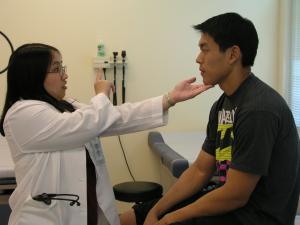Healthcare-associated infections reduced by statewide campaign
University of Hawaiʻi at MānoaContact:
Posted: Mar 30, 2011
Hawaiʻi health care providers have made impressive strides in reducing one of the most dangerous infections striking patients in hospitals and health care facilities. “Central Line Infections," as they are called, have declined by 65% since 2009, the result of a concentrated effort here to tackle the problem.
The Hawaiʻi Comprehensive Unit-Based Safety Program’s “Stop Blood Stream Infections” campaign was launched two years ago, and it spread quickly to all island hospitals.
“We were able to get something no other state did,” said Dr. Della Lin, the physician leader of the campaign. “We have 100% participation—every single intensive care unit is active in this effort.”
Central line infections develop around catheters, (or tubes), which are inserted near the heart in some seriously ill patients. The tubes allow the delivery of medicines, blood, fluid or other potentially life-saving care. But some patients acquire infections during treatment, caused by a wide variety of common and unusual bacteria, fungi, and viruses. Central line infections are among the healthcare-acquired infections that kill some 99,000 patients a year in the United States, Dr. Lin said.
“We believe with our 65% reduction in central line infections in Hawaiʻi, we have avoided 75 infections and saved up to $7 million in additional health care costs,” Lin said. Patients struck by healthcare-acquired infections require more and longer treatment, escalating costs. Central line infections kill as many as one in four victims.
Reducing central line infections is also a nationwide goal of the American Association of Medical Colleges (AAMC), whose membership includes the University of Hawaii Mānoa John A. Burns School of Medicine (JABSOM). JABSOM, in cooperation with Hawaiʻi’s major hospitals, leads the training of medical students and new physicians (called “Residents”) in Hawaiʻi. An emphasis is placed on “Best Practices” to improve quality and strengthen safety in medicine.
“The hospital teams statewide made the difference in reducing infections,” said Dr. Lin. “It is critical to have those at the patient’s bedside direct this work to be successful. The Residents from JABSOM are a critical part of that team. They are the physicians who will continue to shape quality and safety in healthcare.”
For more information, visit: http://http://www.cdc.gov/hai/

